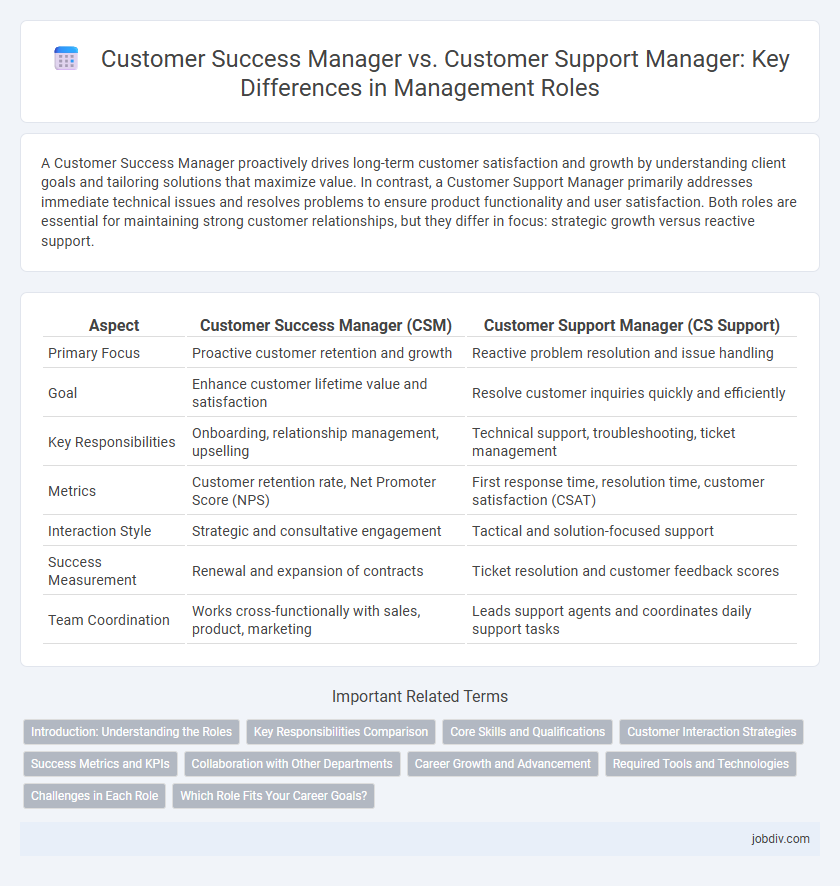A Customer Success Manager proactively drives long-term customer satisfaction and growth by understanding client goals and tailoring solutions that maximize value. In contrast, a Customer Support Manager primarily addresses immediate technical issues and resolves problems to ensure product functionality and user satisfaction. Both roles are essential for maintaining strong customer relationships, but they differ in focus: strategic growth versus reactive support.
Table of Comparison
| Aspect | Customer Success Manager (CSM) | Customer Support Manager (CS Support) |
|---|---|---|
| Primary Focus | Proactive customer retention and growth | Reactive problem resolution and issue handling |
| Goal | Enhance customer lifetime value and satisfaction | Resolve customer inquiries quickly and efficiently |
| Key Responsibilities | Onboarding, relationship management, upselling | Technical support, troubleshooting, ticket management |
| Metrics | Customer retention rate, Net Promoter Score (NPS) | First response time, resolution time, customer satisfaction (CSAT) |
| Interaction Style | Strategic and consultative engagement | Tactical and solution-focused support |
| Success Measurement | Renewal and expansion of contracts | Ticket resolution and customer feedback scores |
| Team Coordination | Works cross-functionally with sales, product, marketing | Leads support agents and coordinates daily support tasks |
Introduction: Understanding the Roles
Customer Success Managers focus on building long-term relationships by proactively ensuring customers achieve their desired outcomes with a product or service, driving retention and growth. Customer Support Managers handle reactive assistance, resolving immediate technical or service issues to maintain customer satisfaction. Both roles are critical in management strategies that enhance overall customer experience and business performance.
Key Responsibilities Comparison
Customer Success Managers focus on proactive relationship building, driving customer adoption, retention, and long-term satisfaction by aligning product value with customer goals. Customer Support Managers handle reactive issue resolution, managing support teams to address technical problems, service requests, and immediate customer concerns efficiently. Both roles require collaboration but differ in strategy, with Customer Success emphasizing growth and Customer Support prioritizing problem-solving.
Core Skills and Qualifications
Customer Success Managers excel in strategic relationship-building, data analysis, and proactive customer engagement to drive long-term retention and growth, requiring skills in CRM software, account management, and business acumen. Customer Support Managers specialize in troubleshooting, team leadership, and handling high-volume inquiries efficiently, needing expertise in technical support processes, customer service software, and conflict resolution. Both roles demand strong communication skills and empathy but differ significantly in focus, with Customer Success prioritizing value delivery and Customer Support emphasizing problem resolution.
Customer Interaction Strategies
Customer Success Managers prioritize proactive engagement with clients by anticipating needs, providing strategic guidance, and fostering long-term relationships to drive retention and growth. Customer Support Managers focus on reactive problem-solving, addressing immediate technical issues and ensuring swift resolution to maintain customer satisfaction. Effective customer interaction strategies differ as Success Managers emphasize education and value creation, while Support Managers concentrate on efficient troubleshooting and responsive communication.
Success Metrics and KPIs
Customer Success Managers focus on proactive success metrics such as Net Revenue Retention (NRR), Customer Lifetime Value (CLV), and churn rate reduction to drive long-term growth. Customer Support Managers prioritize KPIs like First Response Time, Ticket Resolution Time, and Customer Satisfaction Score (CSAT) to address immediate customer needs effectively. Both roles align on improving customer experience but differ in strategic versus tactical performance indicators.
Collaboration with Other Departments
Customer Success Managers collaborate closely with Sales, Product, and Marketing teams to align customer goals with business objectives and drive long-term retention. In contrast, Customer Support Managers primarily coordinate with Technical and Operations departments to resolve immediate customer issues and ensure service efficiency. This cross-functional collaboration enhances both proactive customer success strategies and reactive support workflows.
Career Growth and Advancement
Customer Success Managers (CSMs) typically experience faster career growth with opportunities to evolve into roles like Customer Success Director or VP of Customer Success due to their strategic involvement in driving customer retention and expansion. Customer Support Managers often focus on operational efficiency and team leadership, which can lead to advancement in technical support or service management but may face a more limited strategic scope. The demand for CSMs is rising as companies prioritize proactive customer engagement, translating into broader career advancement paths and higher compensation compared to traditional support roles.
Required Tools and Technologies
Customer Success Managers rely on Customer Relationship Management (CRM) software, data analytics platforms, and customer feedback tools to proactively drive user engagement and satisfaction. Customer Support Managers depend heavily on helpdesk ticketing systems, live chat software, and knowledge base technology to efficiently resolve customer issues. Both roles utilize collaboration tools and communication platforms, but their technology stacks prioritize strategic growth versus reactive problem-solving.
Challenges in Each Role
Customer Success Managers face challenges in proactively driving customer satisfaction and retention by aligning products with evolving client needs, requiring strategic account management and predictive problem-solving skills. Customer Support Managers encounter difficulties managing reactive issue resolution, ensuring timely and effective responses to a high volume of diverse inquiries while maintaining team efficiency and quality standards. Both roles demand strong communication and analytical abilities but differ fundamentally in their approach to customer relationship lifecycle management.
Which Role Fits Your Career Goals?
A Customer Success Manager focuses on proactive relationship building, ensuring clients achieve long-term value and business outcomes, making this role ideal for professionals aiming to drive customer retention and growth. In contrast, a Customer Support Manager handles reactive issue resolution and technical assistance, suited for career goals centered on problem-solving and operational efficiency. Choosing between these roles depends on whether you prefer strategic engagement or hands-on support within customer management.
Customer Success Manager vs Customer Support Manager Infographic

 jobdiv.com
jobdiv.com